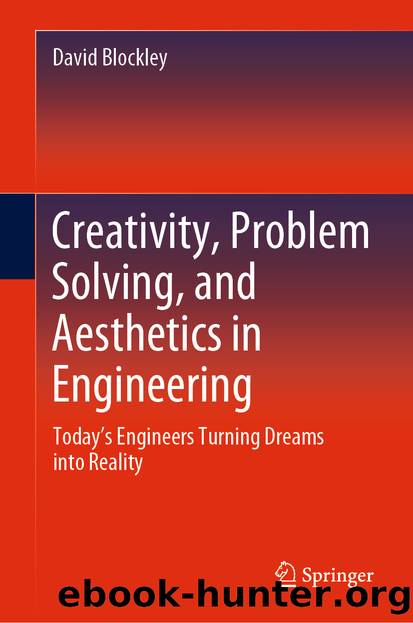Creativity, Problem Solving, and Aesthetics in Engineering by David Blockley

Author:David Blockley
Language: eng
Format: epub
ISBN: 9783030382575
Publisher: Springer International Publishing
Transmitting the Human Voice
As Marconi was developing the radio , Alexander Graham Bell wanted to improve the telegraph . In doing so he invented the telephone. The telegraph was a very limiting way of communicating. Bell wanted to find a better way of transmitting multiple messages over the same wire at the same time. His knowledge of music helped him to conceive the idea of a harmonic telegraph where several notes of different pitches could be sent at the same time. By 1874, Bell had advanced his ideas sufficiently to persuade his future father-in-law to fund him. The following year he had demonstrated that different tones would vary the strength of an electric current in a wire. He just needed to build a transmitter capable of producing varying electrical currents in response to sound waves and a receiver that would reproduce these variations in audible frequencies at the other end of the wire. In 1876, Bell spoke down a wire to his assistant, Thomas A. Watson, in the next room, ‘Mr. Watson—come here—I want to see you’.
A telephone is one of the simplest ways of sending data as syntax but through intonation and language it was the beginning of engineering semantics. A telephone has a switch to connect and disconnect the phone from the network, a microphone and a speaker. In general terms, a microphone is an instrument that responds to varying sound pressure waves in the air and converts them into varying electrical signals. The speaker does the reverse. So, when you speak into a telephone the sound waves of your voice are picked up, in the simplest microphone, by a diaphragm combined with some carbon granules or dust. As the diaphragm vibrates, it compresses the dust which changes resistance, and hence varies the electrical current that flows through the carbon. In a dynamic microphone when the sound waves hit the diaphragm, either a magnet or a coil moves and creates a small current. A speaker takes the electrical signal and translates it back into physical vibrations to create sound waves. When everything is working as it should, the speaker produces nearly the same vibrations that the microphone originally received.
Reginald Fessenden (Fig. 6.6) decided to try using a spark transmitter—rather like a spark plug in a car engine—but with very rapid sparks. The transmitter generates signals as radio frequency waves. Fessenden modulated (changed or modified) the waves using a carbon microphone. In other words, he combined the signal from the spark transmitter with the signal from the microphone. Unfortunately, the sound it made was hardly intelligible. The problem was that the signals from the spark gap transmitters decayed over a broad range of frequencies. What was needed was a well-defined continuous oscillating wave rather than the spark transmitter wave to carry the signal from the microphone. It eventually came via the vacuum tube, perhaps better known as a valve.
Fig. 6.6Reginald Fessenden.
Public domain via Wikipedia Commons. Author Thomas H. White D.W. on en.wikipedia
Download
This site does not store any files on its server. We only index and link to content provided by other sites. Please contact the content providers to delete copyright contents if any and email us, we'll remove relevant links or contents immediately.
Spare by Prince Harry The Duke of Sussex(4980)
Navigation and Map Reading by K Andrew(4951)
Tuesdays with Morrie by Mitch Albom(4570)
Cracking the GRE Premium Edition with 6 Practice Tests, 2015 (Graduate School Test Preparation) by Princeton Review(4161)
Machine Learning at Scale with H2O by Gregory Keys | David Whiting(3916)
Never by Ken Follett(3693)
Goodbye Paradise(3655)
What It Really Takes to Get Into Ivy League and Other Highly Selective Colleges by Hughes Chuck(3632)
Harry Potter and the Prisoner of Azkaban (Book 3) by J. K. Rowling(3242)
Fairy Tale by Stephen King(3139)
Pledged by Alexandra Robbins(3095)
Kick Ass in College: Highest Rated "How to Study in College" Book | 77 Ninja Study Skills Tips and Career Strategies | Motivational for College Students: A Guerrilla Guide to College Success by Fox Gunnar(3033)
Sapiens and Homo Deus by Yuval Noah Harari(2935)
A Dictionary of Sociology by Unknown(2916)
The Social Psychology of Inequality by Unknown(2889)
Reminders of Him: A Novel by Colleen Hoover(2849)
Graduate Admissions Essays, Fourth Edition: Write Your Way into the Graduate School of Your Choice (Graduate Admissions Essays: Write Your Way Into the) by Asher Donald(2819)
Will by Will Smith(2722)
Zero to Make by David Lang(2678)
